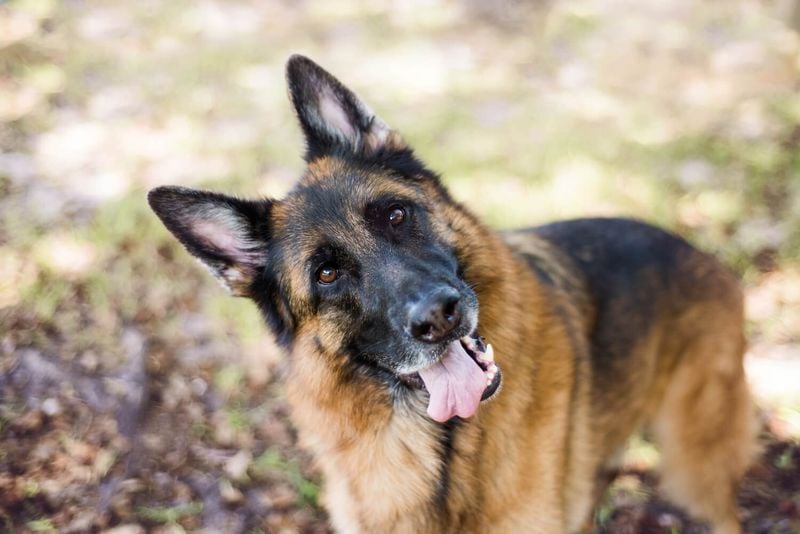20 “Cute” Dog Habits That Are Actually Red Flags
Dogs do lots of adorable things that make us smile, but not all cute behaviors are actually good signs. Some habits we think are just quirky or sweet can actually be your pup’s way of telling you something’s wrong.
Knowing which behaviors might signal health issues or anxiety can help you take better care of your furry friend before small problems become big ones.
1. Frequent Head Tilting
That adorable head tilt might melt your heart, but when it happens too often, it’s time to pay attention. Dogs occasionally tilt their heads to hear better or show curiosity, which is perfectly normal.
Constant or sudden increase in head tilting, however, could indicate ear infections, vestibular disease, or neurological problems affecting your pup’s balance. The inner ear helps dogs maintain equilibrium, and problems here often manifest as head tilting.
If your dog’s cute head tilt becomes persistent or is accompanied by loss of balance, circling, or unusual eye movements, skip the photo opportunity and call your vet instead.
2. Excessive Paw Licking
Many pet parents think their dog is just being extra clean when constantly licking their paws. The rhythmic sound might even seem soothing as your pup grooms themselves on the living room floor.
Unfortunately, this seemingly innocent habit often signals allergies, pain, or anxiety. Dogs lick to soothe irritated skin, relieve joint discomfort, or calm themselves when stressed.
Over time, this behavior creates moist dermatitis—red, inflamed patches called “hot spots.” Watch for redness, hair loss, or if your dog favors certain paws. These signs mean it’s time for a vet visit before the problem worsens.
3. Zoomies (Sudden Bursts of Running)
Those wild running sprees where your dog tears around the house at top speed seem playful and hilarious. Most owners laugh as their pup zooms from room to room, especially after bath time or during play.
While occasional zoomies are normal energy release, frequent or intense episodes might signal pent-up energy from lack of exercise or mental stimulation. Dogs need regular physical activity and enrichment to stay balanced.
When these needs aren’t met, they release frustration through frantic bursts. If your dog gets the zoomies daily or seems unable to calm down afterward, they’re likely telling you they need more walks, play, or training sessions.
4. Leaning Heavily on You
When your furry friend presses their body weight against your legs, it feels like a sweet gesture of affection. Many owners interpret this as their dog wanting closeness or showing love.
Veterinarians recognize that while some leaning is normal bonding behavior, excessive or new leaning patterns can indicate physical weakness, pain, or vision problems. Dogs experiencing joint pain, neurological issues, or failing eyesight often lean for support or guidance.
Pay attention if your previously independent dog suddenly becomes a leaner, especially if accompanied by reluctance to jump, climb stairs, or other changes in mobility. These combinations suggest it’s time for a medical check-up.
5. Tail Chasing
A dog spinning in circles chasing its tail looks comical and entertaining. Young puppies often discover their tails and playfully pursue these mysterious appendages as they explore their bodies.
Persistent tail chasing in adult dogs, however, can develop into a compulsive disorder similar to human OCD. This behavior may begin from boredom or anxiety but can become a self-soothing ritual that’s difficult to interrupt.
When a dog chases their tail for extended periods, seems unable to stop, or becomes agitated when prevented from doing so, it’s no longer cute. These dogs need veterinary behavioral assessment and increased mental stimulation to break the cycle.
6. Smiling or Showing Teeth
That goofy “smile” where your dog pulls back their lips and shows their teeth might look like they’re grinning for the camera. Some owners even train this behavior because it appears so human-like and amusing.
Dog behaviorists call this a “submissive grin” – it’s actually a stress response signaling anxiety or discomfort. Dogs display this expression to communicate they aren’t a threat when feeling nervous or overwhelmed.
Look for other stress signals like whale eye (showing whites of eyes), tense body posture, or avoidance behaviors. If your dog “smiles” during stressful situations like vet visits or when meeting strangers, they’re likely communicating fear, not happiness.
7. Sleeping More Than Usual
Finding your dog snoozing in sunbeams throughout the day seems perfectly normal. After all, most adult dogs sleep 12-14 hours daily, and puppies or seniors even more. A sudden increase in sleeping habits, however, deserves attention.
Excessive sleepiness can indicate health issues like hypothyroidism, diabetes, heart problems, or depression in dogs. Just like humans, dogs show fatigue when fighting illness. Monitor your pet’s energy levels during their typical active periods.
Suppose your normally playful morning companion now sleeps through their usual walk time or seems lethargic when previously energetic. In that case, this change warrants a veterinary check rather than extra Instagram photos of your “lazy” pup.
8. Rolling Over for Belly Rubs Constantly
Your dog flopping over for belly rubs seems like the ultimate display of trust and affection. Those exposed tummies and happy leg kicks are hard to resist! Excessive submission through constant belly exposure, however, might indicate insecurity or anxiety.
While occasional belly-up requests for attention are normal, a dog that immediately rolls over during any interaction may be displaying appeasement behavior rather than seeking affection.
Watch for other submissive signals like avoiding eye contact, tucked tail, or nervous licking. If your dog seems to roll over fearfully rather than playfully, especially with new people or dogs, they may need confidence building through positive training rather than reinforcement of submissive postures.
9. Tilting One Ear
That one perky ear while the other flops down creates an irresistibly cute, slightly confused expression. Many owners find this asymmetrical look endearing and unique to their pup’s personality.
Sudden or persistent ear tilting in a dog with normally symmetrical ears could signal ear problems. Infections, foreign objects, or ear mites can cause discomfort, leading dogs to hold one ear differently than the other.
Beyond ear issues, cranial nerve problems or neurological conditions might manifest through uneven ear carriage. If accompanied by head shaking, scratching at the ear, or balance problems, that charming tilted ear needs veterinary investigation rather than a photo session for your social media feed.
10. Howling Along to Music or Sirens
Your dog’s musical howling sessions when they hear sirens or certain songs might seem hilarious and talented. Many owners proudly share videos of their “singing” companions online.
This behavior actually stems from wolves’ communication instincts. Howling helps pack members locate each other and defend territory. When dogs howl at high-pitched sounds, they’re responding to what they perceive as another dog’s howl in the distance.
While occasional howling is normal, excessive vocal responses to environmental sounds can indicate noise sensitivity or anxiety. If your dog seems distressed rather than playful during these episodes—pacing, trembling, or unable to settle afterward—they may be experiencing genuine sound phobia requiring desensitization training.
11. Bringing You “Gifts” Repeatedly
Finding your dog’s toys piled on your bed or shoes delivered to your feet seems thoughtful and sweet. Many owners interpret this as their dog sharing treasured possessions out of love.
Repetitive gift-bringing can actually signal separation anxiety or attention-seeking behavior. Dogs sometimes gather and present objects to initiate interaction when feeling insecure or needing reassurance.
Pay attention to when this behavior occurs most—before you leave home, after arguments, or during changes in routine. If gift-bringing increases during stressful periods and comes with whining, pacing, or destructive behaviors when you’re not responding, your dog might need help managing anxiety rather than praise for their “generosity.”
12. Staring Intensely at You
Those soulful eyes locked on your every move might seem like pure devotion. Many owners feel special when their dog watches them intently throughout the day. Excessive staring often indicates resource guarding, anxiety, or over-attachment rather than simple affection.
Dogs fixate on sources of food, comfort, or when uncertain about their environment. The staring behavior may represent hypervigilance—constantly monitoring for cues about what happens next.
Notice if intense staring occurs mainly around mealtimes, when you have food, or during times of household tension. If accompanied by stiff body posture, whale eyes (showing whites), or reluctance to break eye contact, this fixation could develop into problematic dependency or guarding behaviors.
13. Clinginess
Having a furry shadow that follows you from room to room feels flattering. This velcro dog behavior seems like the ultimate sign of loyalty and devotion to many pet parents. Extreme clinginess often signals insecurity rather than healthy attachment.
Dogs with separation anxiety or insufficient confidence become overly dependent on their owners for emotional regulation. They struggle to relax when not in direct contact. Watch for distress signals when you create distance—panting, pacing, whining, or destructive behavior when separated by even a door.
True companionship involves comfortable togetherness AND independence. If your dog can’t function without constant contact, working with a behaviorist on confidence-building and gradual separation training will benefit both of you.
14. High-Pitched Barking
That excited, high-pitched yapping when you come home or during playtime seems like enthusiasm and joy. Many owners interpret these soprano outbursts as their dog’s happy voice.
Frequent high-pitched barking often indicates overarousal or frustration rather than happiness. Dogs use higher pitches when emotionally overwhelmed—whether from excitement, anxiety, or when demands aren’t being met.
Look for other signs of stress during these episodes: dilated pupils, stiff movements, inability to respond to commands, or difficulty calming down afterward.
If your dog regularly reaches this pitch during everyday activities, they may be chronically overstimulated. Implementing calm greeting routines and reward-based training for quiet behavior can help your dog learn emotional self-regulation.
15. Trembling or Shivering
That slight quiver when your dog is excited or anticipating a walk looks adorable. Small breeds especially seem to vibrate with joy over the simplest pleasures, earning them the nickname “shaky dogs.”
Regular trembling without obvious causes like cold temperatures or excitement needs investigation. Shivering can indicate pain, anxiety, neurological issues, or even toxin exposure. Senior dogs may develop tremors from muscle weakness or joint discomfort.
Monitor when shaking occurs—during thunderstorms, vet visits, or specific movements. If trembling happens during rest, after exercise, or without environmental triggers, consult your veterinarian.
What looks like cute anticipation might actually be your dog’s way of communicating discomfort that requires medical attention.
16. Puppy Eyes or Sad Gaze
Those soulful, slightly raised eyebrows creating the perfect “sad puppy” expression melt hearts instantly. Evolution has actually enhanced this facial movement in domestic dogs to improve communication with humans.
While dogs do use eyebrow raising to connect with us, constant “sad eyes” might indicate pain or anxiety rather than manipulation for treats. Dogs in discomfort often display worried expressions with furrowed brows and tense facial muscles.
Pay attention to when this expression appears most—during certain movements, after exercise, or in specific environments. If accompanied by changes in activity level, appetite, or sleep patterns, those puppy dog eyes might be communicating genuine distress rather than an attempt to charm you into sharing your sandwich.
17. Overeager Jumping or Licking
An enthusiastic greeting with jumping and face licking seems like pure joy and affection. Many owners feel deeply loved when their dog practically leaps into their arms after a separation.
Excessive jumping and licking often represent anxiety-driven appeasement behaviors rather than balanced excitement. Dogs use these actions to diffuse tension and seek reassurance when feeling insecure or overwhelmed.
Notice if your dog calms quickly after greeting or remains in a heightened state with panting, pacing, or inability to settle. True happiness involves appropriate arousal levels that can be easily regulated.
If your dog’s greetings seem frantic rather than simply happy, implementing structured, calm reunion routines will help them develop healthier emotional responses.
18. Random Digging Indoors
Watching your dog frantically paw at blankets or cushions before settling down looks amusing and instinctual. This “nesting” behavior seems like your pet is simply making their spot more comfortable.
Excessive indoor digging can signal anxiety, overheating, or even hormonal issues rather than normal nesting. Dogs dig to create cooling spots when too warm, or as a displacement behavior when stressed or understimulated.
Monitor when digging occurs most—before sleep, during storms, when alone, or in certain rooms. If accompanied by panting, restlessness, or inability to settle afterward, your dog might be communicating discomfort.
Providing appropriate outlets for natural digging instincts outdoors and addressing underlying anxiety can help redirect this behavior constructively.
19. Excessive Tail Wagging
A vigorously wagging tail seems like the universal sign of a happy dog. Many owners gauge their pet’s joy by how fast that tail swings back and forth. Tail language is actually more complex than simply “wagging equals happiness.”
The speed, height, and direction of tail movement communicate different emotional states. A low, fast wag with tense body posture often signals nervousness or even aggression rather than joy.
Look at the whole dog, not just the tail. A truly happy wag involves a relaxed body, open mouth, and fluid movement. If your dog’s tail is wagging rapidly while their body remains stiff, ears back, or mouth closed, they may be communicating stress or conflict rather than pleasure.
20. Sudden Cuddling After Being Left Alone
Your dog’s extra-snuggly behavior after you’ve been gone seems like they missed you terribly. Those desperate cuddles and refusal to leave your side feel like proof of their deep attachment.
Clingy behavior after separation often indicates separation anxiety rather than healthy affection. Dogs with separation distress experience genuine panic when alone, then seek excessive reassurance upon reunion to manage their emotional state.
Check for other signs—household destruction, complaints about barking while you’re gone, or exhaustion after separation. True separation anxiety requires professional intervention with behavior modification and sometimes medication.
While the post-absence cuddles seem sweet, addressing the underlying panic during alone time will improve your dog’s quality of life.


























